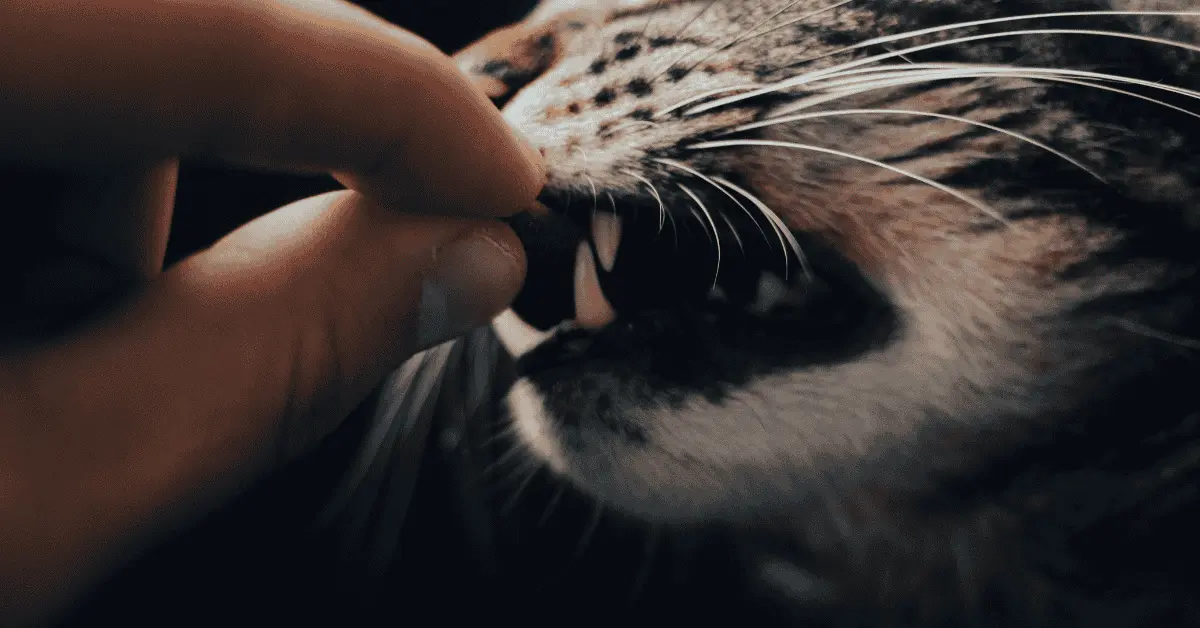If your cat has ever bitten you, you’re not alone. Cat biting is a natural form of communication but can be confusing, painful, and sometimes concerning. From gentle love bites to defensive or aggressive biting, understanding why cats bite and how to respond effectively is key to creating a safe, loving environment for both you and your feline friend.
This guide provides a thorough explanation of cat biting behavior, the reasons behind it, and actionable, expert-backed strategies to help you stop your cat from biting — with a focus on reading your cat’s body language, using positive reinforcement, and preventing biting through environmental and behavioral adjustments.
Table of Contents
ToggleWhy Does My Cat Bite Me? Understanding Cat Biting Behavior
Cats bite for many reasons, and it’s important to identify the cause to address the behavior properly.
1. Overstimulation: When Too Much Is Too Much
Petting or playtime can quickly become overwhelming. Overstimulation leads cats to bite as a signal to say “I’ve had enough.”
Common signs of overstimulation include:
-
Rapid tail flicking or swishing
-
Flattened ears pinned back
-
Dilated pupils showing agitation
-
Twitching skin or rippling fur
-
Sudden head turns or attempts to move away
Recognizing these signs helps you stop interaction before biting occurs.
2. Playful Biting: A Natural Kitten Behavior
Kittens use biting to develop hunting and social skills. Adult cats may continue playful biting, but it should be guided appropriately.
How to discourage biting during play:
-
Redirect play to interactive toys such as wand toys, laser pointers, or catnip toys.
-
Never allow hands or feet to be used as playthings.
3. Fear and Defensive Biting: Protecting Themselves
Cats may bite when they feel threatened, scared, or cornered.
Warning signs include:
-
Arched back with fur standing on end
-
Hiding, crouching low to the ground
-
Dilated pupils and rapid breathing
-
Erratic or swatting movements
It’s essential to provide a safe retreat space and avoid forcing interactions.
4. Redirected Aggression: Frustration Turned on You
A cat might become frustrated by stimuli they cannot reach — such as seeing birds or other cats outside — and redirect this aggression toward a nearby person or pet.
To manage redirected aggression:
-
Provide ample play and exercise to channel energy
-
Minimize exposure to triggers when possible
5. Pain or Illness: Sudden Behavior Changes
If your cat suddenly starts biting, it could be due to pain or health problems like dental disease or arthritis. A veterinary checkup is crucial.
How to Stop Your Cat from Biting: Expert Training & Prevention Tips
Here are practical, effective steps to reduce and stop biting behavior:
1. Learn to Read Your Cat’s Body Language
Body language is your best tool to prevent bites.
Watch for:
-
Tail flicks or twitches (irritation)
-
Flattened ears (defensiveness)
-
Whiskers pulled back (fear or stress)
-
Slow blinking (comfort and trust)
Respect your cat’s signals and stop interaction when irritation is detected.
2. Redirect Biting to Toys
Use toys to satisfy hunting instincts — feather wands, laser pointers, and catnip toys are excellent choices. Rotate toys to keep your cat engaged.
Never use your hands or feet as toys to avoid confusion.
3. Use Positive Reinforcement
Reward gentle play and calm behavior with treats, praise, or extra playtime. Clicker training can help mark good behavior instantly.
4. Keep Play Sessions Short
Long play sessions can lead to overstimulation and biting. Stop play before your cat becomes agitated.
5. Create a Calm and Stress-Free Environment
Provide hiding spots, consistent routines, and consider pheromone diffusers such as Feliway Cat Calming Diffuser to reduce anxiety.
6. Never Punish Your Cat
Punishment can increase fear and aggression, worsening biting. Use calm, consistent redirection and positive reinforcement instead.
7. Seek Professional Help When Necessary
Persistent or sudden biting should be evaluated by a veterinarian or certified animal behaviorist.
Medical Concerns: Handling Cat Bites Safely
Cat bites can transmit bacteria like Pasteurella and Bartonella henselae, which can cause infections.
If bitten:
-
Wash wound immediately with soap and water
-
Apply pressure to stop bleeding
-
Monitor for signs of infection (redness, swelling, pus)
-
Seek medical attention if symptoms worsen
For detailed info, see PetMD’s Guide to Cat Bites.
Frequently Asked Questions (FAQs)
Q1: How do I discipline my cat for biting?
Redirect biting toward toys and reward calm behavior. Avoid punishment.
Q2: How can I stop my cat from biting me?
Understand their body language, respect boundaries, and use interactive toys during play.
Q3: What deters cats from biting?
A calm environment, consistent redirection, and positive reinforcement deter biting.
Q4: At what age do cats stop biting?
Most cats reduce biting naturally between 6 and 12 months, especially with proper socialization.
Conclusion: Foster a Loving, Bite-Free Bond
Cat biting is a form of communication that can stem from play, fear, overstimulation, or health issues. By understanding these causes and responding with patience and positive techniques, you can stop biting behavior and deepen your bond.
Consistency, respect for boundaries, and a stimulating yet calm environment are key. Avoid punishment, and if biting persists, seek expert advice. With care and attention, you can enjoy a peaceful, loving relationship with your cat.




